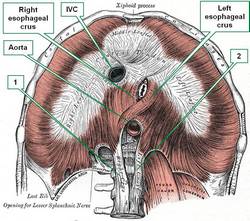The word [crus] is Latin (cruris) and refers to the leg, or region of the shin. It is commonly used to mean "leg" or "pillar". The plural form is [crura].
Several authors suggest a relation of [crus] with another Latin term [crux] meaning "cross" as if a cross is formed by two [crura] (legs).
The term crus is widely used in human anatomy:
- crus cerebri: there are two crus cerebri in the anterior aspect of the mesencephalon
- crura of the penis: the posterior aspect of the corpora cavernosa firmly attached to the ischiopubic rami
- crura of the clitoris: the posterior aspect of the corpora cavernosa firmly attached to the ischiopubic rami
- crura fornix cerebrii: the posterior converging bands that form the fornix of the cerebrum
Special mention is deserved by the crura of the diaphragm. There are two pairs of diaphragmatic crura. The esophageal crura (right and left) which bound the passageway of the esophagus from the thorax into the abdomen, the esophageal hiatus. The esophageal crura have a muscular structure. The aortic crura (righ and left) allow for passage of the aorta into the abdomen, and although muscular superiorly, they are mostly tendinous. The accompanying image shows an anteroinferior view of the respiratory diaphragm. Click on the image for a larger picture.
Sources:
1. "The Origin of Medical Terms" Skinner, HA 1970 Hafner Publishing Co.
2. "Medical Meanings - A Glossary of Word Origins" Haubrich, WD. ACP Philadelphia
3 "Tratado de Anatomia Humana" Testut et Latarjet 8 Ed. 1931 Salvat Editores, Spain
4. "Anatomy of the Human Body" Henry Gray 1918. Philadelphia: Lea & Febiger
Image modified by CAA, Inc. Original image by Henry Vandyke Carter, MD., courtesy of bartleby.com




